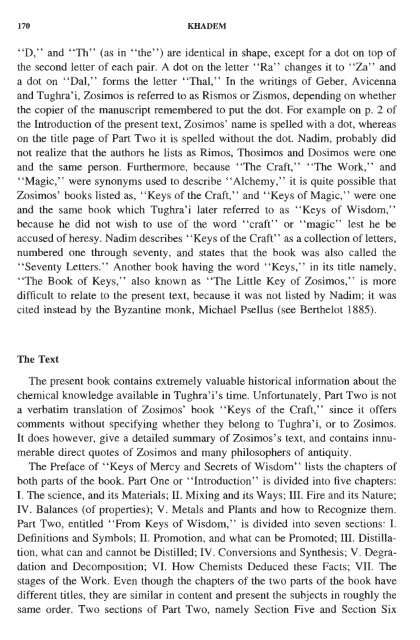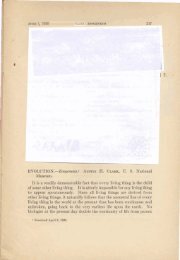A Translation of a Zosimos' Text in an Arabic Alchemy Book
A Translation of a Zosimos' Text in an Arabic Alchemy Book
A Translation of a Zosimos' Text in an Arabic Alchemy Book
Create successful ePaper yourself
Turn your PDF publications into a flip-book with our unique Google optimized e-Paper software.
170 KHADEM<br />
"D," <strong>an</strong>d "Th" (as <strong>in</strong> "the") are identical <strong>in</strong> shape, except for a dot on top <strong>of</strong><br />
the second letter <strong>of</strong> each pair. A dot on the letter "Ra" ch<strong>an</strong>ges it to "Za" <strong>an</strong>d<br />
a dot on "Dal," forms the letter "Thal," In the writ<strong>in</strong>gs <strong>of</strong> Geber, Avicenna<br />
<strong>an</strong>d Tughra'i, Zosimos is referred to as Rismos or Zismos, depend<strong>in</strong>g on whether<br />
the copier <strong>of</strong> the m<strong>an</strong>uscript remembered to put the dot. For example on p. 2 <strong>of</strong><br />
the Introduction <strong>of</strong> the present text, <strong>Zosimos'</strong> name is spelled with a dot, whereas<br />
on the title page <strong>of</strong> Part Two it is spelled without the dot. Nadim, probably did<br />
not realize that the authors he lists as Rimos, Thosimos <strong>an</strong>d Dosimos were one<br />
<strong>an</strong>d the same person. Furthermore, because "The Craft," "The Work," <strong>an</strong>d<br />
"Magic," were synonyms used to describe "<strong>Alchemy</strong>," it is quite possible that<br />
<strong>Zosimos'</strong> books listed as, "Keys <strong>of</strong> the Craft," <strong>an</strong>d "Keys <strong>of</strong> Magic," were one<br />
<strong>an</strong>d the same book which Tughra'i later referred to as "Keys <strong>of</strong> Wisdom,"<br />
because he did not wish to use <strong>of</strong> the word "craft" or "magic" lest he be<br />
accused <strong>of</strong> heresy. Nadim describes "Keys <strong>of</strong> the Craft" as a collection <strong>of</strong> letters,<br />
numbered one through seventy, <strong>an</strong>d states that the book was also called the<br />
"Seventy Letters." Another book hav<strong>in</strong>g the word "Keys," <strong>in</strong> its title namely,<br />
"The <strong>Book</strong> <strong>of</strong> Keys," also known as "The Little Key <strong>of</strong> Zosimos," is more<br />
difficult to relate to the present text, because it was not listed by Nadim; it was<br />
cited <strong>in</strong>stead by the Byz<strong>an</strong>t<strong>in</strong>e monk, Michael Psellus (see Berthelot 1885).<br />
The <strong>Text</strong><br />
The present book conta<strong>in</strong>s extremely valuable historical <strong>in</strong>formation about the<br />
chemical knowledge available <strong>in</strong> Tughra'i's time. Unfortunately, Part Two is not<br />
a verbatim tr<strong>an</strong>slation <strong>of</strong> <strong>Zosimos'</strong> book "Keys <strong>of</strong> the Craft," s<strong>in</strong>ce it <strong>of</strong>fers<br />
comments without specify<strong>in</strong>g whether they belong to Tughra'i, or to Zosimos.<br />
It does however, give a detailed summary <strong>of</strong> <strong>Zosimos'</strong>s text, <strong>an</strong>d conta<strong>in</strong>s <strong>in</strong>nu-<br />
merable direct quotes <strong>of</strong> Zosimos <strong>an</strong>d m<strong>an</strong>y philosophers <strong>of</strong> <strong>an</strong>tiquity.<br />
The Preface <strong>of</strong> "Keys <strong>of</strong> Mercy <strong>an</strong>d Secrets <strong>of</strong> Wisdom" lists the chapters <strong>of</strong><br />
both parts <strong>of</strong> the book. Part One or "Introduction" is divided <strong>in</strong>to five chapters:<br />
I. The science, <strong>an</strong>d its Materials; 11. Mix<strong>in</strong>g <strong>an</strong>d its Ways; 111. Fire <strong>an</strong>d its Nature;<br />
IV. Bal<strong>an</strong>ces (<strong>of</strong> properties); V. Metals <strong>an</strong>d Pl<strong>an</strong>ts <strong>an</strong>d how to Recognize them.<br />
Part Two, entitled "From Keys <strong>of</strong> Wisdom," is divided <strong>in</strong>to seven sections: I.<br />
Def<strong>in</strong>itions <strong>an</strong>d Symbols; 11. Promotion, <strong>an</strong>d what c<strong>an</strong> be Promoted; 111. Distilla-<br />
tion, what c<strong>an</strong> <strong>an</strong>d c<strong>an</strong>not be Distilled; IV. Conversions <strong>an</strong>d Synthesis; V. Degra-<br />
dation <strong>an</strong>d Decomposition; VI. How Chemists Deduced these Facts; VII. The<br />
stages <strong>of</strong> the Work. Even though the chapters <strong>of</strong> the two parts <strong>of</strong> the book have<br />
different titles, they are similar <strong>in</strong> content <strong>an</strong>d present the subjects <strong>in</strong> roughly the<br />
same order. Two sections <strong>of</strong> Part Two, namely Section Five <strong>an</strong>d Section Six







